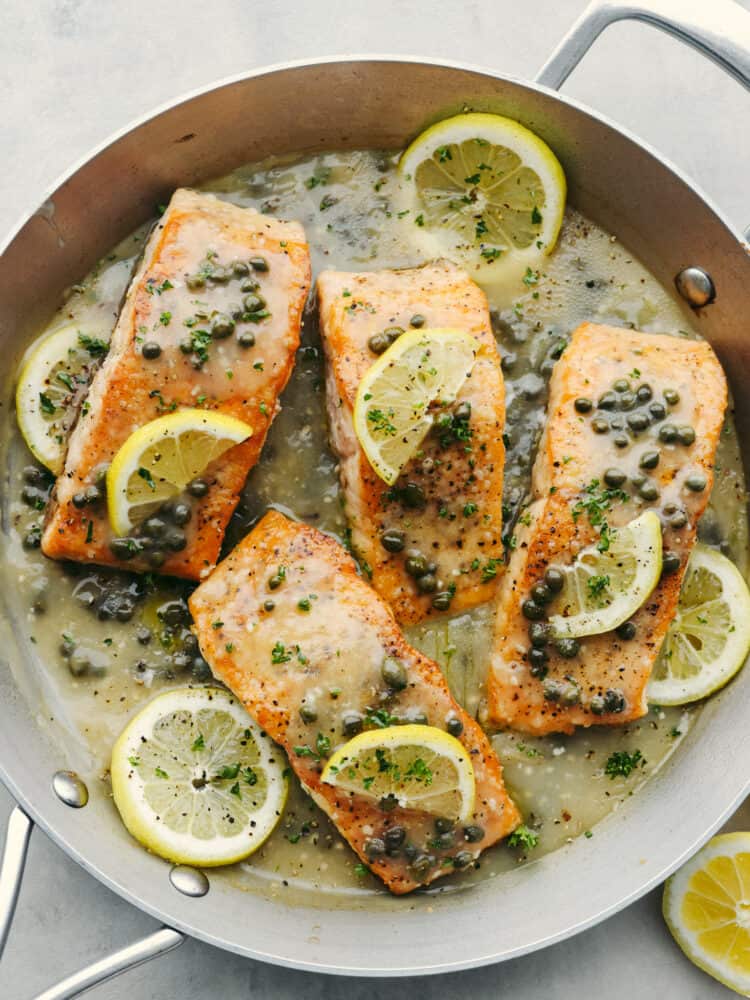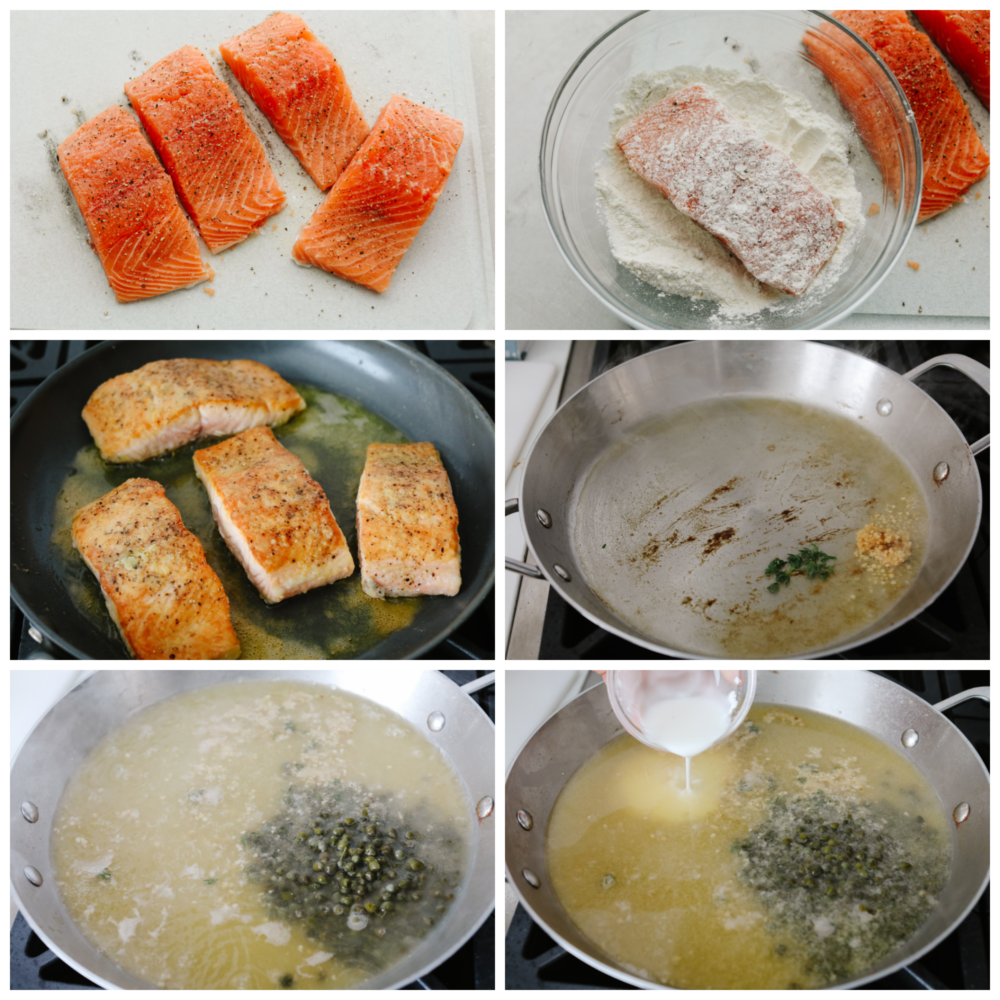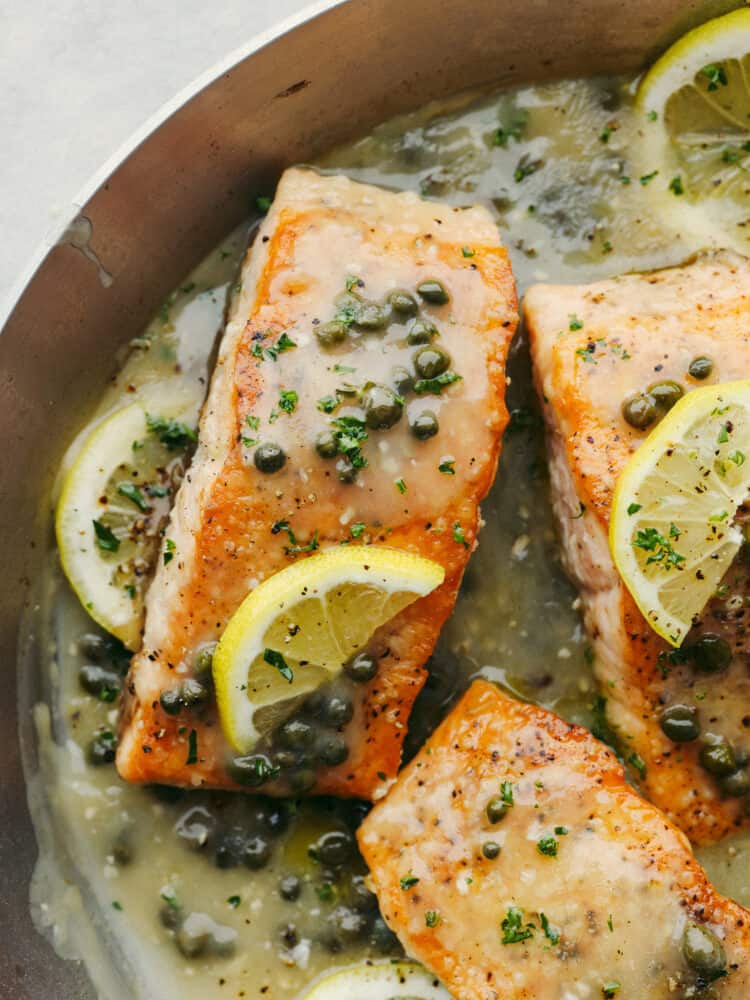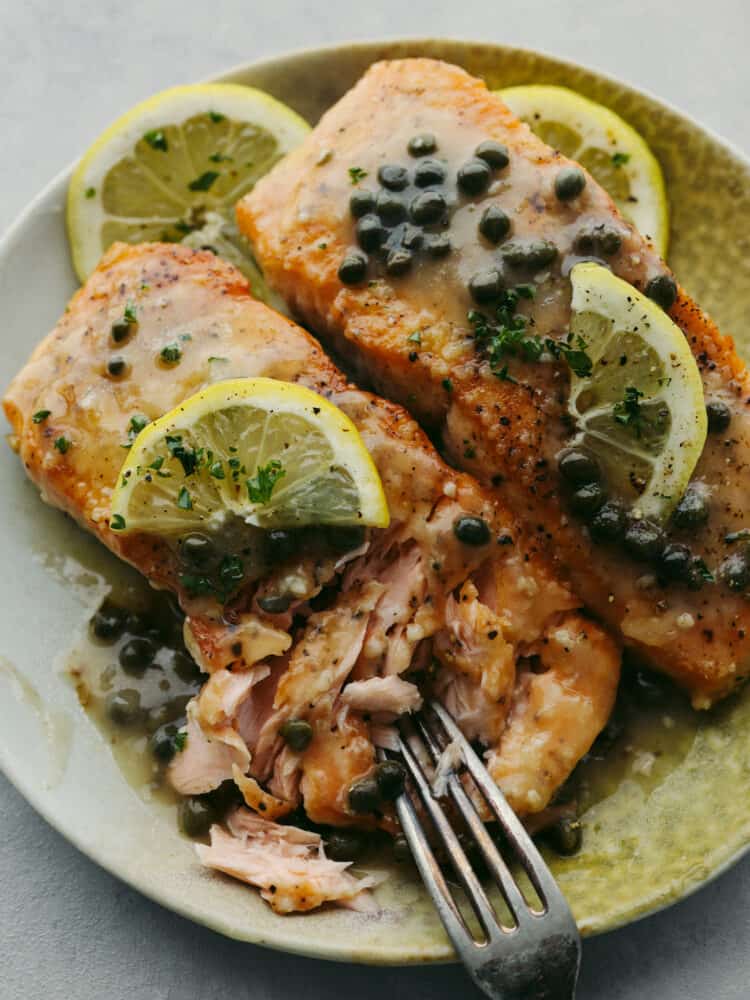This website may contain affiliate links and advertising so that we can provide recipes to you. Read my privacy policy.
This easy salmon piccata is a delicious yet elegant meal that is great for a weeknight meal or for when you have guests over. The flakey pan-seared salmon nestled in a bed of a creamy lemon and caper sauce will definitely be a crowd-pleaser!
I love this dish because of the delicious combination of salmon and lemon when paired together. The flavor of lemon is complementary to so many other dishes. You should give some of my other favorites a try, like this pasta, chicken, or shrimp recipes!

What is Salmon Piccata?
Salmon piccata is fresh salmon filets seasoned and coated in flour to give it a nice golden crust on the outside. Searing the outside of the salmon gives it a crispy texture but still allows for the salmon to be flakey and tender on the inside. The creamy lemon and caper sauce is packed with flavor and takes this dish to the next level!
I have cooked chicken piccata before and I wanted to try something similar with salmon. I love it when I can just swap out one particular meat for the other. After all, it makes it easier to satisfy all of the picky eaters in my household! That’s why I love cooking because you can make it your own and be creative. This salmon piccata is no exception and it’s a meal that your entire family will love! Serve it with these easy and delicious dinner rolls and everyone at the table will leave full!
What Ingredients Do I Need to Make Salmon Piccata?
Salmon piccata may seem like it has a lot of ingredients, but it is actually very easy to put together! Don’t be intimidated at all, my easy step-by-step instructions will help you along the way. See the recipe card at the bottom of the post for exact measurements.
- Olive Oil: Searing the salmon filets in olive oil helps give them a nice golden crust.
- Salmon Filets: The fresh salmon filets are the star of the show.
- Salt and Pepper: Season the salmon with salt and pepper to help balance and bring out flavors.
- Flour: Coating the salmon in flour will create a crispy outer layer.
- White Wine: This is a delicious addition to help deglaze the pan and flavor your salmon.
- Garlic: The garlic flavors the sauce and salmon.
- Fresh Thyme: Fresh herbs always make a recipe stand out.
- Chicken Broth: The chicken broth helps to add flavor to the sauce.
- Capers: You can leave these out, but give them a try, they are my favorite!
- Lemon Juice: Fresh is ALWAYS best!
- Cornstarch and Water: This is used as a thickener for the sauce.
How to Make Salmon Piccata
Salmon Piccata is so simple and comes together in under 30 minutes! All the steps can be made in the same skillet, which makes cleanup fast.
- Season and Coat: In a medium nonstick skillet add the olive oil over medium-high heat. Salt and pepper the salmon filets. Add the flour to a shallow bowl and coat each side.
- Cook: Add the salmon skin side down and cook for 4-5 minutes on each side. Flip and continue to cook until the top has a golden brown cut and the salmon flakes easily.
- Make the Sauce: Remove the salmon and set aside on a plate. Add the garlic to the pan and cook for 20 seconds. Add the white wine and fresh lemon juice, and whisk to deglaze the pan. Stir in the thyme and chicken broth.
- Thicken: In a small bowl whisk the cornstarch and water. Add to the sauce and whisk until it starts to thicken.
- Combine: Add the salmon back to the sauce and spoon the sauce on top. Serve immediately.

Quick Tips For Cooking Salmon
Here are some tips for cooking your salmon just right! Follow these easy steps so that your salmon piccata turns out perfectly!
- Don’t move the salmon too much: When searing the filets, move them as little as possible so that they form a nice golden crust.
- Don’t overcook it! The cooking time depends on the thickness of the filets. You can test the doneness with a fork when it is opaque and easily flakes.
- Cook it to the right temperature: The FDA recommends cooking salmon to an internal temperature of 145 degrees Fahrenheit. To check the temperature, insert a food thermometer in the thickest part of the salmon filet until it reads 140-145 degrees Fahrenheit.

How to Store Leftovers
This salmon piccata can be enjoyed a couple of times throughout the week after you make it if you have leftovers! You can also store it in the freezer for a weeknight meal when you’re in a pinch and don’t have time.
- Refrigerator: Once you salmon has cooled then store in an air-tight container. Put it in the fridge and it will last for up to 3 days.
- Freezer: Allow salmon to cool completely, then store in an air-tight container or wrap in foil. Freeze for up to three months. When ready, thaw overnight in the fridge, then reheat until warmed through.
- To Reheat: You don’t want to have dry salmon! To make sure that it retains its moisture when you reheat it, cooking it on low and slow is best. Put it in the oven at about 275 degrees Fahrenheit and warm it for about 15 minutes. The internal temperature should read 140-145 when it is ready to eat!

-
In a medium nonstick skillet add the olive oil over medium-high heat. Salt and pepper the salmon filets. Add the flour to a shallow bowl and coat each side.
-
Add the salmon skin-side down and cook for 4-5 minutes on each side. Flip and continue to cook until the top has a golden brown cut and the salmon flakes easily.
-
Remove the salmon and set it aside on a plate. Add the garlic to the pan and cook for 20 seconds. Add the white wine and fresh lemon juice, and whisk to deglaze the pan. Stir in the thyme and chicken broth.
-
In a small bowl whisk the cornstarch and water. Add to the sauce and whisk until it starts to thicken.
-
Add the salmon back to the sauce and spoon the sauce on top. Serve immediately.
Serves: 4
Calories458kcal (23%)Carbohydrates30g (10%)Protein38g (76%)Fat18g (28%)Saturated Fat3g (15%)Polyunsaturated Fat5gMonounsaturated Fat9gCholesterol96mg (32%)Sodium625mg (26%)Potassium960mg (27%)Fiber2g (8%)Sugar1g (1%)Vitamin A165IU (3%)Vitamin C18mg (22%)Calcium52mg (5%)Iron4mg (22%)
All nutritional information is based on third party calculations and is only an estimate. Each recipe and nutritional value will vary depending on the brands you use, measuring methods and portion sizes per household.









